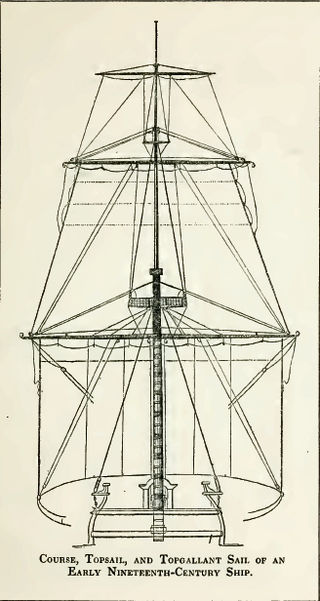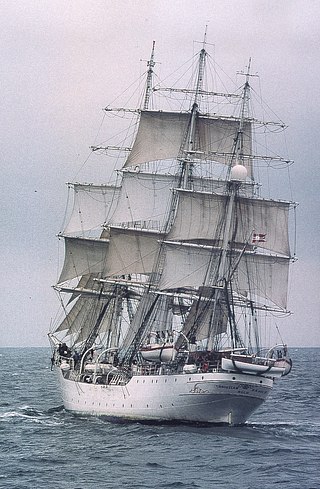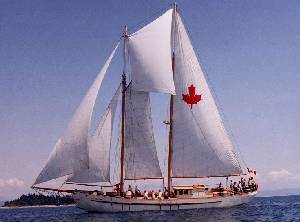
A schooner is a type of sailing vessel defined by its rig: fore-and-aft rigged on all of two or more masts and, in the case of a two-masted schooner, the foremast generally being shorter than the mainmast. A common variant, the topsail schooner also has a square topsail on the foremast, to which may be added a topgallant. Differing definitions leave uncertain whether the addition of a fore course would make such a vessel a brigantine. Many schooners are gaff-rigged, but other examples include Bermuda rig and the staysail schooner.

A sailboat or sailing boat is a boat propelled partly or entirely by sails and is smaller than a sailing ship. Distinctions in what constitutes a sailing boat and ship vary by region and maritime culture.

A sailing vessel's rig is its arrangement of masts, sails and rigging. Examples include a schooner rig, cutter rig, junk rig, etc. A rig may be broadly categorized as "fore-and-aft", "square", or a combination of both. Within the fore-and-aft category there is a variety of triangular and quadrilateral sail shapes. Spars or battens may be used to help shape a given kind of sail. Each rig may be described with a sail plan—formally, a drawing of a vessel, viewed from the side.

A brigantine is a two-masted sailing vessel with a fully square-rigged foremast and at least two sails on the main mast: a square topsail and a gaff sail mainsail. The main mast is the second and taller of the two masts.

A brig is a type of sailing vessel defined by its rig: two masts which are both square-rigged. Brigs originated in the second half of the 18th century and were a common type of smaller merchant vessel or warship from then until the latter part of the 19th century. In commercial use, they were gradually replaced by fore-and-aft rigged vessels such as schooners, as owners sought to reduce crew costs by having rigs that could be handled by fewer men. In Royal Navy use, brigs were retained for training use when the battle fleets consisted almost entirely of iron-hulled steamships.
A jib is a triangular sail that sets ahead of the foremast of a sailing vessel. Its tack is fixed to the bowsprit, to the bows, or to the deck between the bowsprit and the foremost mast. Jibs and spinnakers are the two main types of headsails on a modern boat.

A topsail ("tops'l") is a sail set above another sail; on square-rigged vessels further sails may be set above topsails.

A staysail ("stays'l") is a fore-and-aft rigged sail whose luff can be affixed to a stay running forward from a mast to the deck, the bowsprit, or to another mast.

Gaff rig is a sailing rig in which the sail is four-cornered, fore-and-aft rigged, controlled at its peak and, usually, its entire head by a spar (pole) called the gaff. Because of the size and shape of the sail, a gaff rig will have running backstays rather than permanent backstays.

A full-rigged ship or fully rigged ship is a sailing vessel with a sail plan of three or more masts, all of them square-rigged. Such a vessel is said to have a ship rig or be ship-rigged, with each mast stepped in three segments: lower, top, and topgallant.

Thomas W. Lawson was a seven-masted, steel-hulled schooner built for the Pacific trade, but used primarily to haul coal and oil along the East Coast of the United States. Named for copper baron Thomas W. Lawson, a Boston millionaire, stock-broker, book author, and president of the Boston Bay State Gas Co., she was launched in 1902 as the largest schooner and largest sailing vessel without an auxiliary engine ever built.

A ringtail a sail which is set abaft (behind) a fore-and-aft sail to increase the total sail area of a sailing vessel in light winds. It may be three or four-sided.

The Maple Leaf is a schooner built in 1904, making it British Columbia's oldest tall ship. In 1906, the Maple Leaf was the only Canadian vessel to qualify for the first ever Trans-Pac sailing race, which was slated to take place in San Francisco but never took place due to the massive earthquake that occurred in that year.

Windeward Bound is a two-masted brigantine-rigged vessel based in Hobart, Tasmania, Australia. The vessel is named after Lewis Winde, the builder of an 1848 Boston schooner on which Windeward Bound was modelled. It is constructed almost entirely of Tasmanian eucalypt, huon pine and Oregon pine, recycled from old boats and buildings. The hull is constructed of 5 cm hardwood strip planks, over epoxy-laminated douglas fir frames, spaced 38 cm apart. The stem, sternpost and keel are of epoxy-laminated Tasmanian blue gum and the decks are of huon and New Zealand kauri pines.

Literally, the word pinisi refers to a type of rigging of Indonesian sailing vessels. A pinisi carries seven to eight sails on two masts, arranged like a gaff-ketch with what is called 'standing gaffs' — i.e., unlike most Western ships using such a rig, the two main sails are not opened by raising the spars they are attached to, but the sails are 'pulled out' like curtains along the gaffs which are fixed at around the centre of the masts.
Alexandria was a cargo-carrying three-masted schooner built in 1929. Originally named Yngve, she was built at Björkenäs, Sweden, and fitted with a 58 H.P. auxiliary oil engine.

Matthew Turner was an American sea captain, shipbuilder and designer. He constructed 228 vessels, of which 154 were built in the Matthew Turner shipyard in Benicia. He built more sailing vessels than any other single shipbuilder in America, and can be considered "the 'grandaddy' of big time wooden shipbuilding on the Pacific Coast."

Amazing Grace is an 83' topsail schooner. Its home port is in San Juan, Puerto Rico. The ship serves as the platform for the non-profit Maritime Leadership and is also available for private charters and memorials at sea. Maritime Leadership provides traditional sail training adventures through sailings ranging from 3–48 hours.
The following outline is provided as an overview of and topical guide to sailing:

A sail plan is a drawing of a sailing craft, viewed from the side, depicting its sails, the spars that carry them and some of the rigging that supports the rig. By extension, "sail plan" describes the arrangement of sails on a craft. A sailing craft may be waterborne, an iceboat, or a sail-powered land vehicle.


















